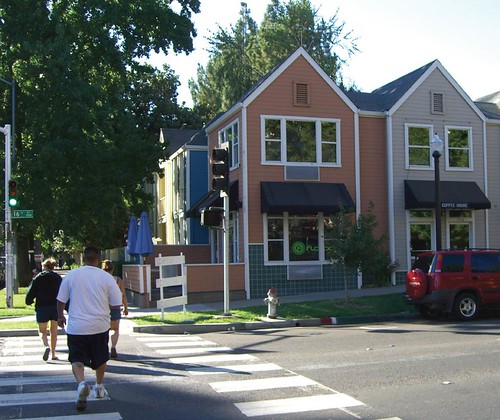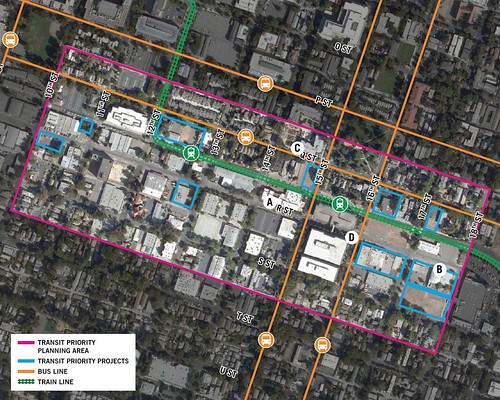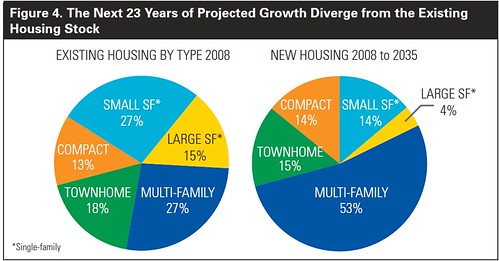How California is planning growth for a prosperous economy and clean environment

Posted September 25, 2012 at 1:32PM
A thorough new report developed by my colleagues at the Natural Resources Defense Council, together with Move LA, a transportation and smart development partnership in southern California, documents the impressive progress made over the last four years to ensure that our nation’s most populous state will absorb future growth in a sensible way. Called Bold Plans for California Communities, the report traces the history and implementation of the state’s landmark planning framework, adopted by the state legislature and signed by then-governor Arnold Schwarzenegger in 2008.
California’s planning framework
In California, laws tend to be known by bureaucratic names or abbreviations and numbers (think Proposition 13 or AB 32). The planning legislation, known by most as Senate Bill 375 or simply “SB 375,” wisely takes account of the growth pressures facing the state – population is expected to increase about ten percent in each coming decade – and directs each of its metropolitan planning organizations to coordinate transportation investment, land use and housing so that growth occurs efficiently while minimizing emissions and other environmental impacts. The most significant environmental provisions of the law direct the California Air Resources Board to develop and assign transportation emissions targets for each region, and then requires each region to develop a detailed strategy to assure that those targets are met. The Air Board must review the plans and certify that each is adequate to meet the targets. It’s not quite that simple, of course, but that’s the general idea.
This was heralded at the time as a big deal, and indeed it was. SB 375 was the nation’s first law to link transportation and land use planning with greenhouse gas emissions. It was a long time in the making.
But by the time of its passage in 2008 the law enjoyed tremendous support from a diverse collection of commercial, real estate, government, housing and environmental interests. These parties (including NRDC) worked long and hard together and with members of the legislature until they came up with something all could agree on: for example, the planning process would direct new development to places that would reduce emissions growth, but it would also include significant legal protections to land developers who followed the new plans; there would be safeguards to promote an adequate supply of affordable housing, but all types of housing, from large-lot, single-family homes to multi-family apartments and everything in between would be permitted so long as the targets would be met; and so on. I taught SB 375 in a class at George Washington University Law School earlier this year and, while I can assure you that it is nothing if not complex, it is also balanced and fair.
 Today, the law is being implemented: three of California's four largest major metropolitan regions – Southern California, Sacramento, and San Diego – have adopted their plans, called sustainable communities strategies, technically parts of their transportation plans. Those three metros comprise two-thirds of the state’s population. The fourth region, the San Francisco Bay Area, is expected to adopt its plan early next year.
Today, the law is being implemented: three of California's four largest major metropolitan regions – Southern California, Sacramento, and San Diego – have adopted their plans, called sustainable communities strategies, technically parts of their transportation plans. Those three metros comprise two-thirds of the state’s population. The fourth region, the San Francisco Bay Area, is expected to adopt its plan early next year.
The report finds much to praise in the new plans:
“As intended by SB 375, each region created its own tailored mix of land use decisions, transportation investments, and policies to achieve its target. These sustainable community strategies lay the foundation for smarter, more efficient growth and much healthier communities, while setting a high benchmark for the rest of California’s regions.”
A total of 18 metro regions must eventually be in compliance with SB 375.
The emerging plans
The report finds that the Sacramento Region’s strategy is the best to date. Indeed, a 2004 plan called the Sacramento Blueprint was in many ways a prototype for the kind of effort that would eventually be required of all regions. The Blueprint provided for the region to absorb 1.7 million additional people and a million additional jobs by 2050 while, among many other things, saving 59 square miles of farmland and ranchland from permanent conversion to development, and retaining 65 percent of the region’s housing in single-family homes and farmhouses.
The new Sacramento region plan builds upon the Blueprint. The report’s authors note that it will allow a 39 percent population increase by 2035 while actually decreasing traffic congestion (measured as congested vehicle travel per capita). This is because of investments in new housing and jobs in walkable neighborhoods near transit, reducing per capita vehicle travel by around 9 percent compared to 2008 levels; the plan is projected to increase the number of trips made by transit, walking, or bicycling by nearly 33 percent. Significantly, the region’s footprint of developed land would expand by only 7 percent despite the much larger population increase.
I’ve reported before on the details of the laudable new strategy for Southern California, whose metro region boundary covers an astounding 38,000 square miles, including 191 cities and more than 18 million residents. The SoCal strategy aggressively invests in public transit to serve both current residents and four million new ones, along with 4.2 million new jobs, 87 percent of which would be within a half mile’s walk of transit service. The new strategy is also projected to reduce pollution-caused respiratory problems by 24 percent, resulting in $1.5 billion per year in health care savings, and to save over 400 square miles of farmland and other open space from development.
As Chuck Marohn’s new book Thoughts on Building Strong Towns (which I reviewed last week) makes abundantly clear, growth strategies that avoid extensions of infrastructure to previously undeveloped areas also save fiscal resources over time. Locating jobs, homes, and other common destinations in closer and more accessible places also enables households to save expenses for transportation. These measures help the economy just as much as they help the environment. The plans also align with market trends by increasing the supply of multi-family and small-lot homes, expected to claim a much larger share of overall housing demand than in the past as more baby boomers downsize empty nests while the millennial generation seeks more urban settings.
The report’s evaluation of the adopted strategy for San Diego is more guarded (the strategy is in litigation). But it notes that the plan does dedicate “more funding for transit than any previous regional transportation plan” while increasing bicycle and pedestrian funding threefold over the last transportation plan.
Additional tools and resources that would assist implementation
Bold Plans for California Communities includes a number of policy recommendations to help ensure effective implementation of the new community strategies. These include reform of the state’s approach to redevelopment, which was altered significantly (and, in my opinion, unfortunately) by the abolition of California’s redevelopment agencies in 2011. 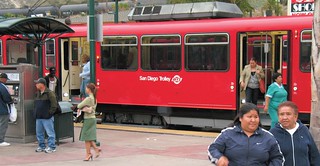 These agencies had provided tools to local jurisdictions that made blighted urban locations more attractive for investment, financed affordable housing, eased investments to upgrade infrastructure, and permitted the consolidation of underutilized property to spur projects.
These agencies had provided tools to local jurisdictions that made blighted urban locations more attractive for investment, financed affordable housing, eased investments to upgrade infrastructure, and permitted the consolidation of underutilized property to spur projects.
The report recommends a reconceived program that would target redevelopment funds to neighborhoods meeting the walkability and transit criteria of SB 375. Perhaps more important, it also recommends that a trust fund be established to support affordable housing, financed through a small fee on home sales. This would compensate somewhat for the loss of affordable housing funds when the redevelopment agencies were dissolved.
I won’t discuss all of the report’s recommendations, but there are some in particular that I really like, including the suggestion that other metropolitan planning organizations adopt a best practice from the Sacramento region concerning environmental review of the regional strategy. In particular, the Sacramento Area Council of Governments structured the environmental impact report accompanying its regional planning documents so that the EIR can be readily referenced in tiered environmental documents prepared for on-the-ground developments that conform to the regional strategy. The regional EIR even includes templates for sponsors of conforming local projects to use so the local and regional documents will be properly aligned. 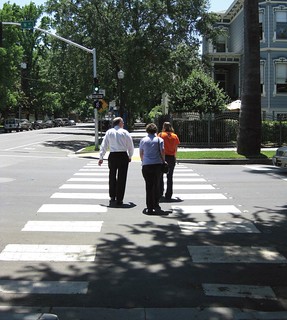 This will, in effect, “streamline the streamlining process” provided to sustainable projects under SB 375 so that they can be built more quickly and with less administrative cost.
This will, in effect, “streamline the streamlining process” provided to sustainable projects under SB 375 so that they can be built more quickly and with less administrative cost.
The report also includes important recommendations to support transit equity and minimize displacement of current residents affected by revitalization; to strengthen consideration of public health in planning (by adopting a best practice from the Southern California region); to employ “regional advance mitigation planning” that enables the consolidation of land and ecological mitigation efforts into larger and more effective initiatives; and to address issues related to funding, performance evaluation, and parking requirements.
Congratulations to the principal authors of Bold Plans for California Communities -- Amanda Eaken (she has also written a blog post about the report), Justin Horner, and Gloria Ohland – as well as to my NRDC colleagues involved in the editorial, design, and production process. Visit NRDC’s web site for more information and to download the report.
Related posts:
- SoCal's new sustainability strategy is impressive step forward (April 12, 2012)
- A strong case for a rail- and transit-oriented California (January 9, 2012)
- How a California city is cleaning up, building green, & protecting residents from pollution (October 6, 2011)
- New California report shows well-planned land use could dramatically reduce pollution, household costs (June 24, 2010)
- ULI gives strong endorsement to California smart growth law (June 10, 2010)
- How the new California smart growth law will work (October 15, 2008)
- NY Times applauds California smart growth law (October 7, 2008)
Move your cursor over the images for credit information.
